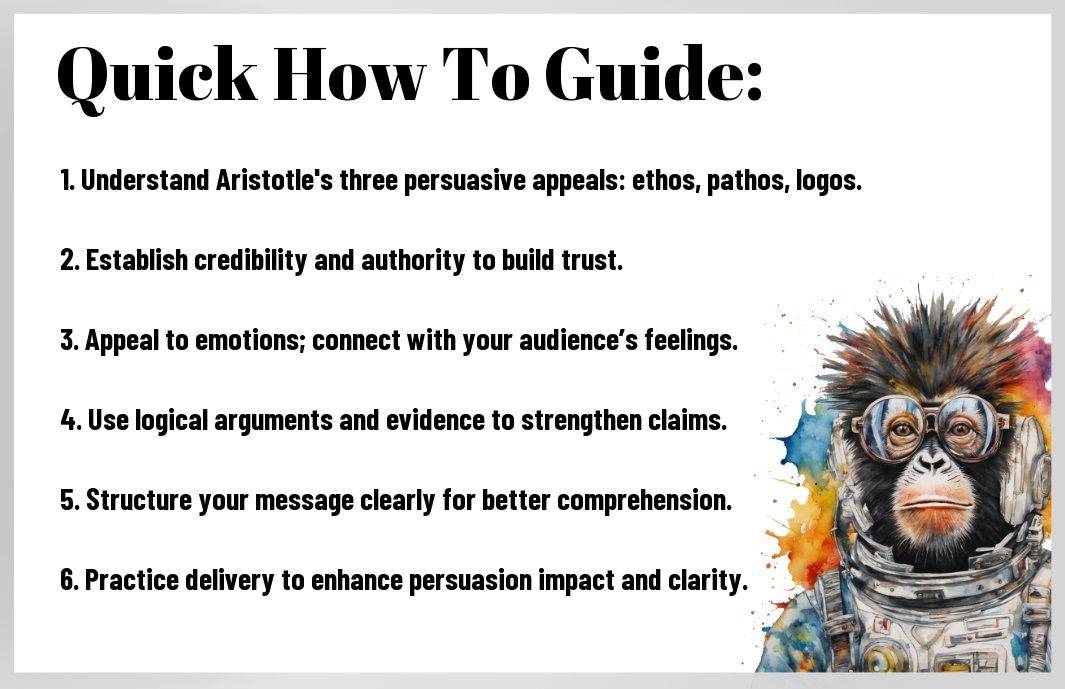Rhetoric is an art that can transform the way you communicate your ideas and influence others. In this post, I’ll guide you through the vital elements of persuasion based on Aristotle’s timeless principles. Whether you’re preparing a presentation, writing an email, or having a conversation, these techniques will help you connect with your audience and make your arguments more compelling. Let’s examine the world of rhetorical strategies and unlock the power of persuasion together!
Key Takeaways:
- Ethos: Establish your credibility and authority to gain trust from your audience.
- Pathos: Appeal to the emotions of your audience to create a connection and persuade effectively.
- Logos: Use logical reasoning and evidence to support your arguments and validate your claims.
- Structure: Organize your argument clearly; a well-structured presentation enhances understanding and retention.
- Audience Awareness: Tailor your message to resonate with your specific audience’s values and beliefs.
- Techniques: Employ rhetorical devices such as metaphors, anecdotes, and rhetorical questions to engage your audience.
- Practice: Refine your rhetoric skills through practice and feedback to improve your persuasive abilities over time.


Understanding Rhetoric
While I was exploring into the world of persuasion, I found that understanding rhetoric is key to becoming an effective communicator. It’s not just about what you say, but how you say it. Rhetoric is the art of persuasion, involving strategies to influence others by appealing to their emotions, logic, and credibility. This ancient practice, rooted in classical education, remains relevant today, serving as a toolkit for anyone looking to make their voice heard and their ideas accepted. Understanding the different elements of rhetoric can empower you to tailor your message for maximum impact.
What is Rhetoric?
One of the most fascinating aspects of rhetoric is its multifaceted nature. It encompasses various techniques and styles that can elevate your communication. Aristotle identified three key appeals: ethos, pathos, and logos. Ethos relates to credibility, pathos touches on emotions, and logos appeals to logic. By balancing these elements, you can craft a compelling argument that resonates with your audience. This interplay is what makes rhetoric such a powerful tool; it gives you the ability to connect with people on different levels.
Why Rhetoric Matters
What I’ve realized in my journey is that rhetoric matters because it shapes our interactions and influences outcomes. Whether I’m writing a blog post, giving a presentation, or even having a casual conversation, the principles of rhetoric can guide me in communicating more effectively. It’s not merely an academic concept; it’s a practical skill that can enhance your ability to persuade, inform, and engage others. In today’s information-saturated world, the ability to articulate your thoughts persuasively sets you apart and helps you build stronger connections with your audience.
Rhetoric, at its core, is about power—power to inspire action, change minds, and foster understanding. Practicing rhetorical techniques is not just an exercise in eloquence; it’s about being strategic with your words to achieve your desired outcome. Whether you’re crafting an argument for a debate, pitching an idea at work, or trying to connect with friends on a meaningful topic, mastering rhetoric can help you navigate different conversations with confidence and authenticity.
The Three Appeals of Persuasion
Clearly, understanding Aristotle’s components of persuasion can significantly enhance your ability to influence others. These components, known as the three appeals—ethos, pathos, and logos—serve as the foundational elements of effective rhetoric. Each appeal addresses different aspects of human cognition and emotion, enabling you to craft persuasive messages that resonate with your audience. Let’s explore each of these appeals in more detail, beginning with establishing your credibility through ethos.
Ethos: Establishing Credibility
You might think of ethos as the character or credibility that you bring to your argument. When persuading your audience, it’s vital to establish yourself as trustworthy and knowledgeable about the topic at hand. You can achieve this by sharing relevant experiences, qualifications, or acknowledging any potential biases. By doing so, you create a space where your audience feels more inclined to listen and consider your perspective seriously. After all, if they see you as an authority, they are more likely to trust what you say.
Pathos: Connecting Emotionally
Emotionally appealing to your audience can be a powerful strategy in persuasion. You want them to feel connected to your message, which often means tapping into their emotions, desires, or fears. By storytelling or using vivid imagery, you can evoke feelings that resonate with your listeners, prompting them to care about your argument on a deeper level. When people feel emotionally invested, they are much more likely to respond to your message positively and even act upon it.
It’s amazing how an emotional connection can shift perspectives. When I weave relatable anecdotes into my arguments, I often see a change in tone among my audience. They start to nod their heads, share their own stories, and become more engaged with the topic. It’s not just about presenting facts; it’s about making your audience feel something worthwhile that connects them to the core of your message.
Logos: The Power of Logic
You can’t overlook the importance of logos, which refers to the logical appeal of your argument. When crafting your message, ensure that it is well-structured and supported by facts, statistics, or logical reasoning. A clear presentation of evidence can help validate your claims and strengthen your case. If your argument logically makes sense, your audience will be more inclined to accept it and may even be persuaded to take action based on that rationale.
Plus, incorporating data and logical reasoning makes your argument more compelling. I find that when I balance emotional appeals with solid logic, I create a robust case that stands on its own. People appreciate when they can follow an argument that makes sense logically, allowing them to understand not just how they should feel, but why they should feel that way. By weaving all three appeals together, you can create a well-rounded and persuasive message that resonates deeply with your audience.
Crafting Your Argument
To successfully persuade others, it’s crucial to craft your argument thoughtfully. Aristotle emphasized the importance of rhetoric as a tool for effective communication, and structuring your message clearly is one of the first steps in this process. When I begin this journey, I ensure I have a well-defined thesis statement that outlines my main point. This statement serves as the backbone of my argument and guides my direction. A well-structured argument not only makes it easier for my audience to follow but also lends credibility to what I am presenting. You might find it helpful to outline your main points logically, ensuring each one flows into the next with a connective thread that reinforces your core message.
Structuring Your Message
Little details can make a significant difference when it comes to structuring my message. For instance, I like to employ the classic structure of introduction, body, and conclusion. In the introduction, I capture my audience’s attention and present my thesis statement. The body is where I examine into supporting arguments, providing a logical arrangement that builds upon each point. Finally, I conclude by summarizing my main ideas and reiterating why they matter. Following this simple structure can transform my message from a series of disjointed thoughts into a compelling narrative that resonates with my audience.
Supporting Your Claims
If you want to effectively persuade, it’s imperative that you support your claims with strong evidence. I often draw upon statistics, anecdotes, expert opinions, or relevant examples that bolster my argument. Whenever I can, I try to incorporate a mix of appeal to ethos, pathos, and logos to create a well-rounded approach that resonates with a wider audience. This not only gives weight to my claims but also helps to foster a connection with my audience, allowing them to see the validity of my perspective.
Supporting your arguments with credible evidence goes beyond just impressing your audience; it builds trust. When I share facts, figures, and stories, I’m showing that I’ve done my homework, and I’m aiming to provide a solid foundation for my points. You’ll notice that by backing up your claims thoughtfully, you’ll not only be more persuasive but also more respected as a speaker or writer. Your audience is likely to respond positively when they see that you respect their intelligence by providing well-researched and compelling support for your arguments.
Tips for Effective Communication
Once again, effective communication relies on how well you express your thoughts and connect with your audience. Here are some tips that can help you in your journey to become a more persuasive speaker:
- Know your audience
- Maintain eye contact
- Use body language effectively
- Be clear and concise
- Practice active listening
After incorporating these tactics into your conversations and presentations, you’ll find that your ability to persuade others improves significantly.
Choosing the Right Words
Now, when it comes to choosing the right words, the vocabulary I use can set the tone for my entire message. I strive to select words that resonate with my audience, conveying my ideas clearly and compellingly. By avoiding jargon or overly complex language, I can ensure that my message is not only understood but also appreciated.
Moreover, I often find that incorporating storytelling elements and metaphors enhances my communication. These techniques make my points relatable and memorable, leaving a lasting impression on my listeners. Opting for simple yet powerful language helps me to connect more deeply with my audience.
Engaging Your Audience
Right from the start, engaging your audience is necessary for effective communication. I focus on actively involving my listeners, creating an environment where they feel part of the conversation. This could be as simple as asking open-ended questions or inviting them to share their thoughts and experiences. By doing so, I make it easier for them to connect with my message and feel invested in the outcome.
Another technique I’ve found helpful is to modulate my tone and pace while speaking. This not only captures attention but also keeps the atmosphere lively and engaging. Additionally, incorporating visuals or anecdotes can grab my audience’s interest and make the discussion more relatable. These strategies together help create a more interactive experience, prompting my audience to participate actively and engage fully with my message.
Factors That Influence Persuasion
Not everyone is easily persuaded, as various factors can play a significant role in how effectively I can influence someone. Understanding these factors allows me to connect more meaningfully with my audience. Here are a few key elements to keep in mind:
- The credibility of the speaker.
- The emotions evoked by the message.
- The logical arguments presented.
- Social and cultural norms.
- The medium through which the message is delivered.
Any of these factors can significantly affect my persuasive efforts, and choosing the right mix can mean the difference between being ignored and being impactful.
Understanding Your Audience
There’s a lot to gain from truly understanding your audience. When I take the time to learn about their interests, values, and even their frustrations, I can tailor my message to resonate more deeply. For example, if I know that the majority of my audience values sustainability, I can emphasize the eco-friendly aspects of my argument. This connection builds trust and increases the likelihood that my point of view will be accepted.
Moreover, recognizing the demographics of my audience, such as their age, gender, and cultural background, can further enhance my persuasive tactics. It’s crucial for me to adapt my language, examples, and even my tone, making sure they align with what my audience expects and relates to. Ultimately, investing the effort into understanding who I’m communicating with pays off in the effectiveness of my persuasion.
The Role of Context
The context in which I present my argument is just as vital as the content itself. Factors like current events, social dynamics, and even the physical setting can greatly influence how my message is received. For instance, if I’m speaking about economic changes during a time of financial stability, the audience might be more open to those ideas compared to when they’re facing uncertainty in the market. Understanding the surrounding environment aids me in delivering my message in a manner that’s both timely and relevant.
Understanding the context also involves acknowledging the cultural and situational background of my audience. Different settings might evoke varied responses, and being aware of these nuances allows me to strategically engage my audience. Whether it’s a formal debate or an informal gathering, I can adjust my approach to ensure that my persuasive efforts are aligned with the immediate circumstances. This adaptability can significantly enhance the impact of my communication.

How to Practice Rhetoric Daily
Now, incorporating rhetoric into your daily life can be both enjoyable and rewarding. I often find opportunities to apply the principles of persuasion without even realizing it. Whether I’m discussing plans with friends, negotiating a better deal while shopping, or even convincing my partner about which movie to watch, these little moments are perfect for honing my rhetorical skills. By weaving rhetorical techniques into everyday conversations, I start to notice how effective communication can significantly enhance my interactions and potentially influence their outcomes. So, look for chances to use ethos, pathos, and logos as you engage with others throughout your day.
Applying Rhetoric in Everyday Situations
Now, considering how I can apply rhetoric every day adds a layer of fun to otherwise mundane situations. For instance, when I’m at work presenting an idea to my colleagues, I focus on grounding my argument with data (logos), sharing relatable anecdotes (pathos), and establishing my credibility (ethos). This not only makes my presentation more compelling but also opens up dialogues that encourage everyone to participate. I also try to observe how others communicate and see if I can identify rhetorical devices in action, which helps me develop a keen awareness of the art of persuasion.
Building Your Persuasion Skills
Now, building your persuasion skills doesn’t have to feel like a chore. One of my favorite approaches is to take on debates about light-hearted topics with my friends. We might argue about the best pizza toppings or the ultimate superhero. This playful environment allows me to practice constructing arguments and refining my delivery without pressure. Over time, I start to notice how my ability to persuade grows, and I feel more confident in my communication styles.
Understanding the nuances of persuasion is important. I find that by actively seeking feedback from friends after discussions, I gain insights into what works and what might need adjustment. Additionally, studying influential speakers or reading literature on rhetorical strategies significantly enhances my skills. Incorporating these learning moments into my practice keeps me engaged and allows me to continuously improve my persuasive abilities in a supportive, low-stakes environment.
Conclusion
Summing up, mastering the art of persuasion can transform the way you communicate. By employing Aristotle’s principles of ethos, pathos, and logos, I believe you can significantly enhance your persuasive skills. These elements not only help in building your credibility and connecting with your audience emotionally, but they also allow for rational arguments that resonate on a deeper level. The beauty of rhetoric is that it can be applied in various contexts, whether you’re delivering a speech, writing an essay, or simply trying to convince a friend to try a new restaurant.
If you’re eager to research deeper into the subject and refine your abilities, consider checking out this guide on How to Write Persuasive Rhetoric: 6 Tips for Persuading an …. I encourage you to practice these techniques and observe how they elevate your conversations and presentations. It’s all about connecting with your audience in a meaningful way, and I have no doubt that with a little effort, your persuasive prowess will shine through!
FAQ
Q: What is the main focus of ‘How to Persuade Like Aristotle – Rhetoric Essentials’?
A: The main focus of this resource is to explore the principles of rhetoric as outlined by Aristotle, providing readers with practical techniques and strategies for effective persuasion. It emphasizes the importance of ethos (credibility), pathos (emotional appeal), and logos (logical argument) in crafting compelling messages.
Q: Who can benefit from reading this guide?
A: This guide is beneficial to a wide range of individuals, including students, professionals, writers, marketers, and anyone looking to enhance their persuasive communication skills. It’s particularly useful for those preparing for presentations, speeches, or any form of argumentation where influence is key.
Q: What are the key elements of Aristotle’s rhetoric covered in the guide?
A: The guide breaks down the three key elements of rhetoric: ethos, pathos, and logos. It explains how establishing credibility (ethos), connecting emotionally with the audience (pathos), and presenting logical arguments (logos) can significantly enhance the power of persuasion.
Q: How does the guide suggest one can develop their ethos?
A: To develop ethos, the guide recommends demonstrating knowledge of the subject, being honest, and building a trustworthy relationship with the audience. It also advises on the importance of presenting oneself confidently and being ethical in communication to strengthen credibility.
Q: Can the techniques provided be applied in different contexts, such as writing and speaking?
A: Yes, the techniques discussed in the guide are versatile and can be applied to various contexts, including written communication and verbal presentations. The principles of persuasion are universal and can enhance effectiveness regardless of the medium used.
Q: Does the guide offer practical examples of persuasive techniques in action?
A: Absolutely! The guide includes practical examples from historical speeches, literature, and everyday scenarios to illustrate how Aristotle’s concepts can be applied effectively. These examples help readers see the relevance of the techniques in real-world situations.
Q: Is prior knowledge of rhetoric necessary to understand this guide?
A: No prior knowledge of rhetoric is required to benefit from this guide. It is designed to be accessible to beginners while also providing insights that can enhance the skills of those more familiar with the subject. The explanations are clear and straightforward, making it easy for anyone to grasp the concepts.


